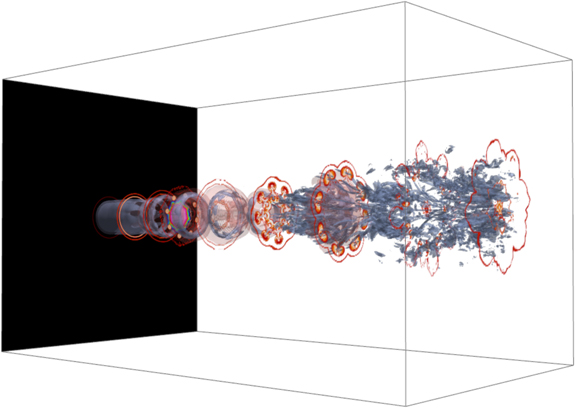Formation of Zinc Nano-crystals in Turbulent Jets
Sean C. Garrick
Jun Liu
Department of Mechanical Engineering
University of Minnesota - Twin Cities
Minneapolis, Minnesota

Image 1
The rising need for clean, renewable energy sources has led to recent studies on hydrogen production via hydrolysis. The idea is to utilize metal nanoparticles to split water into hydrogen and oxygen. The flows consist of hot metal (zinc) vapor issuing into cooler, inert argon gas. As the zinc vapor cools, crystals nucleate, grow and are transported throughout the flow-field. Further downstream, these particles come into contact with water vapor and undergo a surface reaction to produce zinc-oxide and hydrogen gas. We utilize direct numerical simulation and high-performance computing to assess the effects of fluid mixing on crystal formation and growth, and ultimately hydrogen production.

Image 2
The image shows contours of the nanocrystal nucleation rate are shown at different downstream locations across the jet. When the jet becomes turbulent, the rate of mixing increases significantly and nanocrystals form wherever the hot zinc vapor mixes with the cooler argon gas. The crystals are between 0.7 and 1.5 nanometers in diameter, with a large number of the zinc molecules located on the surface of the crystal. The fluid vortices act to increase the rate of mixing and the number of crystals produced. Turbulent flows are very sensitive to small-scale perturbations and the patterns observed due to the non-linear nature of the underlying physics and chemistry. The use of high-performance supercomputers helps us to learn how the crystals form and potentially control their size and structure.
Funding is provided by the Initiative for Renewable Energy & the Environment and the Institute on the Environment at the University of Minnesota. Computational resources are provided by Minnesota Supercomputing Institute.
Reporters and Editors
Reporters may freely use these images. Credit: Professor Sean Garrick, Computational Transport Phenomena Laboratory, University of Minnesota (2010).
